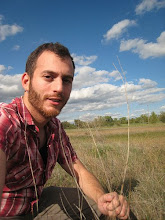The LA Times has a great article and video about the recovery of the green sea turtle recovered from the San Gabriel River.
Seems like the poor thing suffered a lot of abuse before it was rescued!
Friday, October 24, 2008
Monday, September 15, 2008
University by the Sea
It's nearly time for the second annual University by the Sea!
Saturday, October 5, 10 AM to about 6 or 7.
This is a day-long event hosted by Cal State Long Beach in the downtown/east village area. Local luminaries teach classes on various subjects relating to Long Beach, including several classes of interest to environmentally minded folk.
Here are the highlights:
Session 1: 10 - 11 AM.
Breakwater 101
Breakers Building - Wedding Chapel · $5
Surfrider Foundation & 4th District Councilman Patrick O' Donnell, City of Long Beach
Come learn about the Long Beach breakwater - from past to present! Surfrider Foundation will share the breakwater's history - when and why it was built - and discuss how a breakwater configuration could help solve our local water-quality problems. 4th District Councilman Patrick O' Donnell will describe the Army Corps of Engineers Reconnaissance Study process.
Session 2: 11:30-12:30
Plants and People
Utopia Restaurant · $5
Jorge Ochoa, Horticulture Instructor, Long Beach City College
Lecture discussing the benefits of plants to human kind. How plants have shaped people's lives throughout history. To value and understand the life of plants, structure, and functions.
What it Means to be "Green"
Gotama Building Engineers · $5
Nikolas Bruno & Kacie McLamb, Engineers, Gotama Building Engineers Inc.
An academic class on sustainability and a guided tour of a sustainable building.
Session 3: 1-2 PM
Pollution in our Seas - What Happens to the Fish?
Lafayette Building - Tuna Room · $5
Kevin M. Kelley, Professor/Lab Director, CSULB Department of Biological Studies
Powerpoint-based lecture with props for a close-up interactive discussion on how pollution and contaminants impact wildlife in the marine and coastal environment.
Sustaining Your Backyard Garden
East Village Community Garden · $5
Staff, Long Beach Organic
A three-part lecture and Q&A on sustainable living in your backyard: (1) The Apple Guild, (2) Composting, (3) Making the Yard a Wildlife Habitat
What it Means to be "Green"
Gotama Building Engineers · $5
Nikolas Bruno & Kacie McLamb, Engineers, Gotama Building Engineers Inc.
An academic class on sustainability and a guided tour of a sustainable building.
Session 4: 2:30 - 3:30
Green Shopping Guide
Breakers Building - Wedding Chapel · $5
Russ Parsons, Author, "How to Pick a Peach"
Learn the basics of "eat local: eat seasonal" and how shopping at local farmer's markets can lead to better quality, better taste and better value.
Los Angeles River: History, Present & Future
Lafayette Building - Dome Room · $5
Alicia Katano, Education Coordinator, Friends of the L.A. River (FoLAR)
Impacts of urban run-off on river habitat and revitilization projects explored by the front-line fighters for a better L.A. River.
What it Means to be "Green"
Gotama Building Engineers · $5
Nikolas Bruno & Kacie McLamb, Engineers, Gotama Building Engineers Inc.
An academic class on sustainability and a guided tour of a sustainable building.
Session 5: 4-5
Beyond Xeriscape
Utopia Restaurant · $5
Kathleen Thomas, Designer/Horticulturist, CSULB Extension Services
A practical guide to having plants in your life - no matter what color thumb you have. Learn how to create a sustainable, low water use, organic garden, that is simple to care for and looks great!
Session 6: 5:30 - 6:30
Califlora: The Importance of Promoting Native Landscaps in Urban Areas
Utopia Restaurant · $5
Eric Zahn, Plant Ecologist, CSULB
Will demonstrate what native plants are for use in urban gardens and the services they provide. Will do demo on how to care for native plants.
Saturday, October 5, 10 AM to about 6 or 7.
This is a day-long event hosted by Cal State Long Beach in the downtown/east village area. Local luminaries teach classes on various subjects relating to Long Beach, including several classes of interest to environmentally minded folk.
Here are the highlights:
Session 1: 10 - 11 AM.
Breakwater 101
Breakers Building - Wedding Chapel · $5
Surfrider Foundation & 4th District Councilman Patrick O' Donnell, City of Long Beach
Come learn about the Long Beach breakwater - from past to present! Surfrider Foundation will share the breakwater's history - when and why it was built - and discuss how a breakwater configuration could help solve our local water-quality problems. 4th District Councilman Patrick O' Donnell will describe the Army Corps of Engineers Reconnaissance Study process.
Session 2: 11:30-12:30
Plants and People
Utopia Restaurant · $5
Jorge Ochoa, Horticulture Instructor, Long Beach City College
Lecture discussing the benefits of plants to human kind. How plants have shaped people's lives throughout history. To value and understand the life of plants, structure, and functions.
What it Means to be "Green"
Gotama Building Engineers · $5
Nikolas Bruno & Kacie McLamb, Engineers, Gotama Building Engineers Inc.
An academic class on sustainability and a guided tour of a sustainable building.
Session 3: 1-2 PM
Pollution in our Seas - What Happens to the Fish?
Lafayette Building - Tuna Room · $5
Kevin M. Kelley, Professor/Lab Director, CSULB Department of Biological Studies
Powerpoint-based lecture with props for a close-up interactive discussion on how pollution and contaminants impact wildlife in the marine and coastal environment.
Sustaining Your Backyard Garden
East Village Community Garden · $5
Staff, Long Beach Organic
A three-part lecture and Q&A on sustainable living in your backyard: (1) The Apple Guild, (2) Composting, (3) Making the Yard a Wildlife Habitat
What it Means to be "Green"
Gotama Building Engineers · $5
Nikolas Bruno & Kacie McLamb, Engineers, Gotama Building Engineers Inc.
An academic class on sustainability and a guided tour of a sustainable building.
Session 4: 2:30 - 3:30
Green Shopping Guide
Breakers Building - Wedding Chapel · $5
Russ Parsons, Author, "How to Pick a Peach"
Learn the basics of "eat local: eat seasonal" and how shopping at local farmer's markets can lead to better quality, better taste and better value.
Los Angeles River: History, Present & Future
Lafayette Building - Dome Room · $5
Alicia Katano, Education Coordinator, Friends of the L.A. River (FoLAR)
Impacts of urban run-off on river habitat and revitilization projects explored by the front-line fighters for a better L.A. River.
What it Means to be "Green"
Gotama Building Engineers · $5
Nikolas Bruno & Kacie McLamb, Engineers, Gotama Building Engineers Inc.
An academic class on sustainability and a guided tour of a sustainable building.
Session 5: 4-5
Beyond Xeriscape
Utopia Restaurant · $5
Kathleen Thomas, Designer/Horticulturist, CSULB Extension Services
A practical guide to having plants in your life - no matter what color thumb you have. Learn how to create a sustainable, low water use, organic garden, that is simple to care for and looks great!
Session 6: 5:30 - 6:30
Califlora: The Importance of Promoting Native Landscaps in Urban Areas
Utopia Restaurant · $5
Eric Zahn, Plant Ecologist, CSULB
Will demonstrate what native plants are for use in urban gardens and the services they provide. Will do demo on how to care for native plants.
Sunday, September 7, 2008
Los Cerritos Channel
As you may know, green sea turtles were recently sighted swimming up the San Gabriel River. They were seen in the area of the Cerritos Channel, an arm of the San Gabriel River estuary. So of course I had to check it out! Sadly, no turtles were seen during my brief visit, but I thought I'd write it up on this blog, because this unlikely area was full of quite a few surprises.
View Larger Map
There is a small park along Cerritos Channel called Channel View Park.
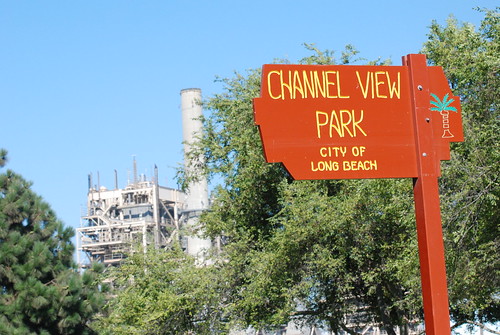
The park is a highly manicured strip of lawn with a bike/pedestrian path, separated from the channel by an ugly chainlink fence. Opportunities to commune with nature here are limited, although if the scenery is appealing in that post-apocolyptic way that comes so easily in southern California:
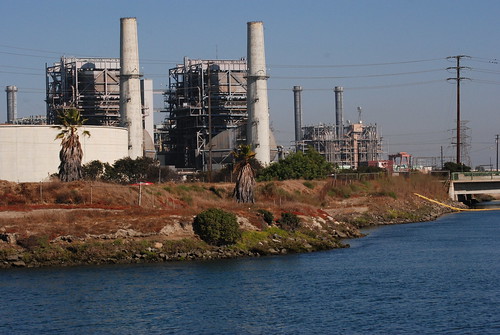
The huge stacks of a powerplant dominate the landscape. The plant takes in water from the river to cool the engines, and returns heated effluent to the San Gabriel river. Both the intake and effluent have deleterious impacts on the marine environment, and these impacts are closely monitored by a number of agencies. The most severe impacts are the death of marine organisms on intake screens, and the alteration of the thermal regime of the river.
As I mentioned, the park itself doesn't offer much access to nature, though you can see quite a bit from the bridges over the channel on Loynes Drive and Studebaker.
Birdlife was somewhat abundant here, with several of the usual suspects:

Cormorants, either perched on the trash booms or here, flying in V-formation.
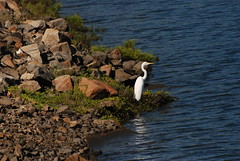
Great egret.
Not shown: belted kingfisher and great blue heron. The vacant lots around the channel show evidence of wild dogs--either strays, or perhaps coyotes!
The contrast between the graceful birds and the imposing industral backgrop can be quite jarring:
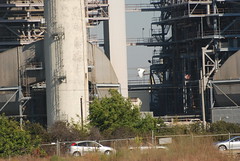
The bridge on Studebaker offers a glimps into muddier habitat than is typical of other parts of the channel, which are full of rocky riprap:

You can see long and elegant smelt swimming at the surface, or even jumping out.

The most exciting sighting of the day were two large-ish octopuses (or octopi--both are correct!) fighting in the shallow water! Sadly, I got no photos to show. But I will be sure to try again sometime soon!
View Larger Map
There is a small park along Cerritos Channel called Channel View Park.

The park is a highly manicured strip of lawn with a bike/pedestrian path, separated from the channel by an ugly chainlink fence. Opportunities to commune with nature here are limited, although if the scenery is appealing in that post-apocolyptic way that comes so easily in southern California:

The huge stacks of a powerplant dominate the landscape. The plant takes in water from the river to cool the engines, and returns heated effluent to the San Gabriel river. Both the intake and effluent have deleterious impacts on the marine environment, and these impacts are closely monitored by a number of agencies. The most severe impacts are the death of marine organisms on intake screens, and the alteration of the thermal regime of the river.
As I mentioned, the park itself doesn't offer much access to nature, though you can see quite a bit from the bridges over the channel on Loynes Drive and Studebaker.
Birdlife was somewhat abundant here, with several of the usual suspects:

Cormorants, either perched on the trash booms or here, flying in V-formation.

Great egret.
Not shown: belted kingfisher and great blue heron. The vacant lots around the channel show evidence of wild dogs--either strays, or perhaps coyotes!
The contrast between the graceful birds and the imposing industral backgrop can be quite jarring:

The bridge on Studebaker offers a glimps into muddier habitat than is typical of other parts of the channel, which are full of rocky riprap:

You can see long and elegant smelt swimming at the surface, or even jumping out.

The most exciting sighting of the day were two large-ish octopuses (or octopi--both are correct!) fighting in the shallow water! Sadly, I got no photos to show. But I will be sure to try again sometime soon!
Labels:
Estuary,
Long Beach,
Los Cerritos Channel,
San Gabriel River
Thursday, September 4, 2008
Colorado Lagoon Restoration

According to an article in today's Grunion Gazette:
The City's Planning Commission is set to certify the Enivornmental Impact Report (EIR) for restoration of Colorado Lagoon!
You can read the entire EIR, which describes the plan and all the expected impacts here:
link
The primary goal of the restoration is to address the poor water quality that afflicts the lagoon and often prevents swimming and other uses. For example, the EIR describes plans to improve storm drains so that pollutant-laden runoff only enters the lagoon in the largest rains.
However, restoration of natural areas is also included in the plans!
Several areas of wetlands will be formed along the margins of the lagoon, and a "bird island" will be created. Eel grass beds in the open water will be restored.
For more details, also check out the Friends of Colorado Lagoon.
Wednesday, September 3, 2008
Sea turtles in Long Beach!
The Press-Telegram has an article about green sea turtles (Chelonia mydas) in Long Beach!
Apparently, about a dozen of the endangered critters are swimming up the San Gabriel river, attracted by the warmth from the powerplant that uses the river to cool its generators.
Read the article here.
Presumably, the turtles are hanging out in the soft-bottomed estuarine portion of the river (south of PCH), and not going into the concrete-lined freshwater portions (pictured below):
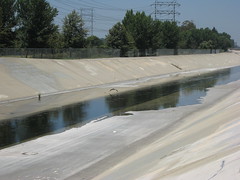
I have never seen turtles in the San Gabriel River, but now that I know they are there, I'll be sure to look!
Apparently, about a dozen of the endangered critters are swimming up the San Gabriel river, attracted by the warmth from the powerplant that uses the river to cool its generators.
Read the article here.
Presumably, the turtles are hanging out in the soft-bottomed estuarine portion of the river (south of PCH), and not going into the concrete-lined freshwater portions (pictured below):

I have never seen turtles in the San Gabriel River, but now that I know they are there, I'll be sure to look!
Labels:
Endangered species,
Long Beach,
San Gabriel River,
Sea turtles
Tuesday, September 2, 2008
Marine Protected Areas
This post is an update to let you know about a meeting hosted by the Long Beach chapter of the Surfrider Foundation.
The meeting is Wednesday, 7 pm at the Barnes and Nobles Bookstore at the Marina Pacifica Mall (6326 E Pacific Coast Highway, Long Beach, CA):
View Larger Map
The meeting concernes Marine Protected Areas--a statewide initiative to establish zones in the ocean and along the coast to protect marine life. The actual regulations in these areas may include prohibitions on commercial or recreational fishing, and may impact a number of other activities.
It is unclear to me (and seems doubtful) that any such areas will include Long Beach, although plenty of nearby areas may be affected, including areas near the Channel Islands.
The meeting is Wednesday, 7 pm at the Barnes and Nobles Bookstore at the Marina Pacifica Mall (6326 E Pacific Coast Highway, Long Beach, CA):
View Larger Map
The meeting concernes Marine Protected Areas--a statewide initiative to establish zones in the ocean and along the coast to protect marine life. The actual regulations in these areas may include prohibitions on commercial or recreational fishing, and may impact a number of other activities.
It is unclear to me (and seems doubtful) that any such areas will include Long Beach, although plenty of nearby areas may be affected, including areas near the Channel Islands.
Wednesday, August 13, 2008
Again?!?!?!?
Our beaches are closed yet again because of a sewage spill. Almost the entire shoreline is affected.
The curretn spill comes from leaking pipes in Watts. These pipes dumped 20,000 gallons of raw sewage into Compton Creek, which is a major tributary of the Los Angeles River. The LA River, of course, is the largest source of water and sediment on our beaches, and poor water quality there has a huge impact on the Long Beach coast.
Would tearing down the breakwater help in this situation? Perhaps, though indirectly. Increased water circulation at the beach might help flush out the sewage once it lands in our front door.
However, we might get a bigger bang-for-the-buck by improving upstream sewage infrastructure so spills like these happen less often.
Read the story in today's LA Times.
In the meantime, here's a photo of our beach in happier, more festive times:

The curretn spill comes from leaking pipes in Watts. These pipes dumped 20,000 gallons of raw sewage into Compton Creek, which is a major tributary of the Los Angeles River. The LA River, of course, is the largest source of water and sediment on our beaches, and poor water quality there has a huge impact on the Long Beach coast.
Would tearing down the breakwater help in this situation? Perhaps, though indirectly. Increased water circulation at the beach might help flush out the sewage once it lands in our front door.
However, we might get a bigger bang-for-the-buck by improving upstream sewage infrastructure so spills like these happen less often.
Read the story in today's LA Times.
In the meantime, here's a photo of our beach in happier, more festive times:

Monday, June 30, 2008
Return to Golden Shores
I made a quick trip back to Golden Shores to see if I could get any better "action shots" of birds in the wild.
And what a day it was!
Lots of foraging snowy egrets:
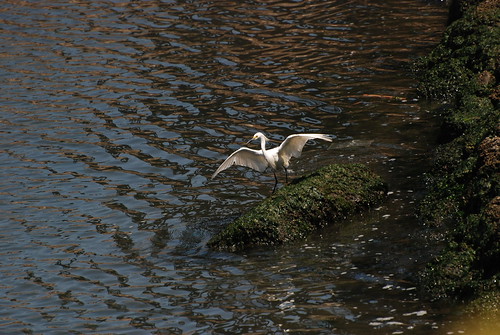
A great blue heron:
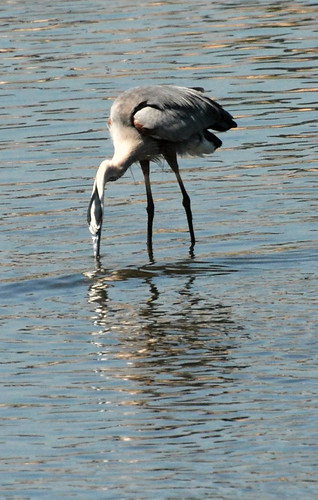
Quite a few caspian terns:
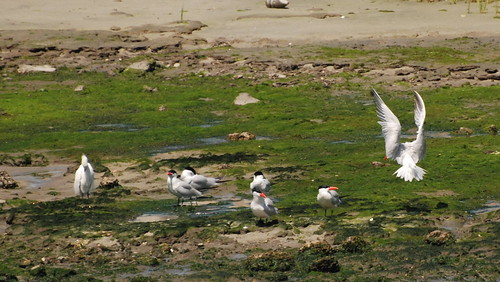
It's great to watch these guys hover and dive for fish!

(The industrial areas of the harbor make quite a backdrop for Golden Shores!)
A juvenile black-crowned night heron was hanging out in a nearby tree:
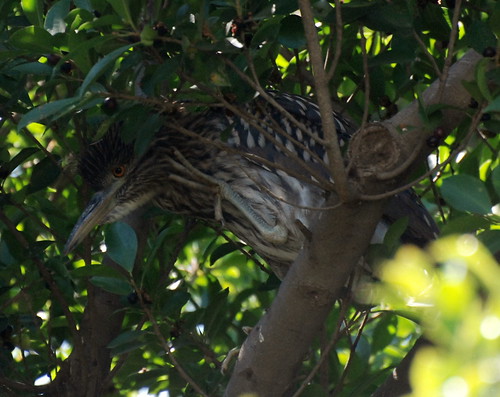
They do look kind of awkward perched like that, but they are quite at home there! Most of these wading birds start there lives in tree-bound rookeries. They nest in huge aggregations of multiple species. In fact, most of the herons and egrets you see were born in just a small number of areas. Protecting these few trees--even in highly urbanized areas--is critical to preserving the species for vast parts of the globe.
The highlight of the day was (for me!) an osprey that was soaring up the LA River!
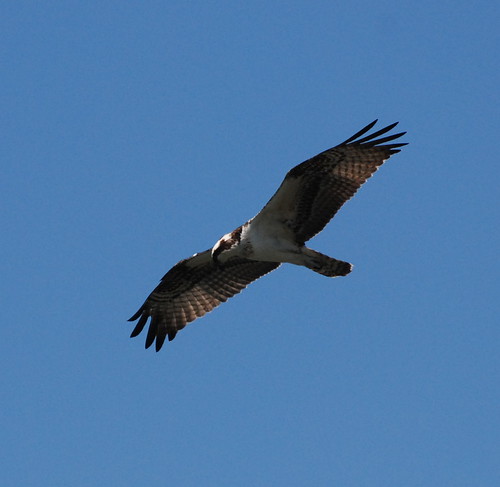
These sea-eagles (as they are sometimes called) feed extensively on fish, and so few of the other birds took notice of this guy, as he was no threat to them.
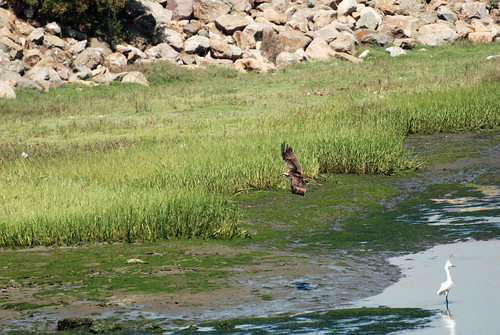
In this photo, you can see how little the snowy egret cares about the osprey flying within a few feet of him!
And what a day it was!
Lots of foraging snowy egrets:

A great blue heron:

Quite a few caspian terns:

It's great to watch these guys hover and dive for fish!

(The industrial areas of the harbor make quite a backdrop for Golden Shores!)
A juvenile black-crowned night heron was hanging out in a nearby tree:

They do look kind of awkward perched like that, but they are quite at home there! Most of these wading birds start there lives in tree-bound rookeries. They nest in huge aggregations of multiple species. In fact, most of the herons and egrets you see were born in just a small number of areas. Protecting these few trees--even in highly urbanized areas--is critical to preserving the species for vast parts of the globe.
The highlight of the day was (for me!) an osprey that was soaring up the LA River!

These sea-eagles (as they are sometimes called) feed extensively on fish, and so few of the other birds took notice of this guy, as he was no threat to them.

In this photo, you can see how little the snowy egret cares about the osprey flying within a few feet of him!
Wednesday, May 21, 2008
Brief notes from Rainbow Lagoon
Remember how I derided Rainbow Lagoon for being overhyped as a natural area?
Well, this little park has surprised me again. I was walking from downtown Pine to the Long Beach Gay Pride celebration, when I noticed a huge school of bass swimming in the shallows!
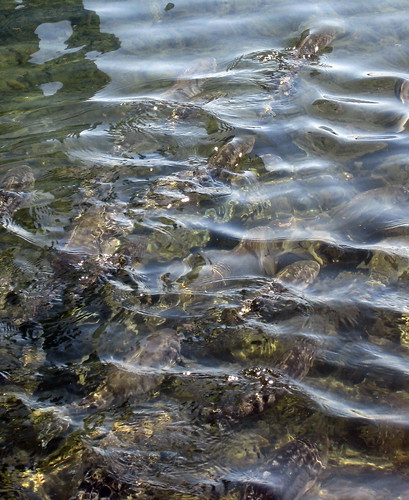
Consultation with my ichthyological buddies have indicated that this was a school of mixed species, including sand bass (Paralabrax nebulifer, top) kelp bass (Paralabrax clathratus, bottom):
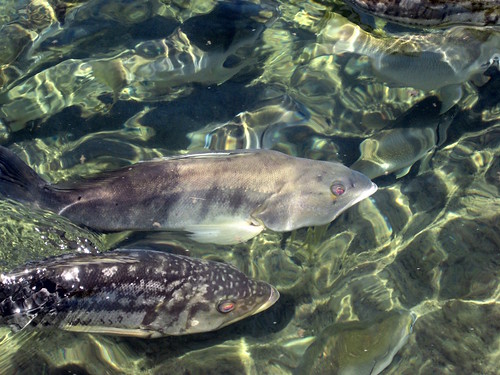
There may have been other species as well!
In deeper (and, sadly, unphotographable) water, I saw a huge flatfish--almost certainly a California halibut (Paralichthys californicus). Definitely keep an eye out for these monsters next time you're by the lagoon!
Where did these fish come from? Did they swim in naturally with the tides? Or (I suspect) were they stocked by the Aquarium as a way of brining the ocean closer to the public?
If anyone knows, send me an email!
Well, this little park has surprised me again. I was walking from downtown Pine to the Long Beach Gay Pride celebration, when I noticed a huge school of bass swimming in the shallows!

Consultation with my ichthyological buddies have indicated that this was a school of mixed species, including sand bass (Paralabrax nebulifer, top) kelp bass (Paralabrax clathratus, bottom):

There may have been other species as well!
In deeper (and, sadly, unphotographable) water, I saw a huge flatfish--almost certainly a California halibut (Paralichthys californicus). Definitely keep an eye out for these monsters next time you're by the lagoon!
Where did these fish come from? Did they swim in naturally with the tides? Or (I suspect) were they stocked by the Aquarium as a way of brining the ocean closer to the public?
If anyone knows, send me an email!
Tuesday, May 13, 2008
Dominguez Gap Wetlands
Long time, no post fellow Long Beachistanis!
Sorry about the cold shoulder... I've been--distracted. By things. Plus, there weren't too many wildernesses left to explore in Long Beach!
All that changed this past weekend, though. We have a brand new wetland!
The Dominguez Gap Wetlands were officially opened to the public this May.

These wetlands are located along the LA River south of Del Amo Boulevard, adjoining DeForest Park. But unlike DeForest, this isn't techinically a "park" and it isn't managed by the Long Beach Parks Department. Instead, it's managed by the LA County Department of Public Works.
Adjacent to the park, you can see the confluence of Compton Creek and the LA River:
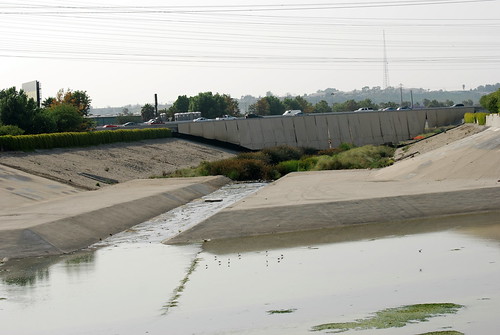
These wetlands aren't at all natural--they were constructed and serve a variety of purposes. Specifically, the wetlands are designed to treat stormwater (removing nutrients and metals before it enters the LA River and the Pacific Ocean. It will also help recharge the groundwater in the area. In addition, the wetland provides habitat for wildlife. And wetland-dependent wildlife is desparate for real estate in southern LA County! (You can learn more about constructed treatment wetlands in this PDF from the EPA).

As you can see, the wetlands are built so that water enters individual cells. In each cell, nutrients and pollutants are removed, before passing on to the next cell. As the water moves through the wetland, more and more pollutants are removed.
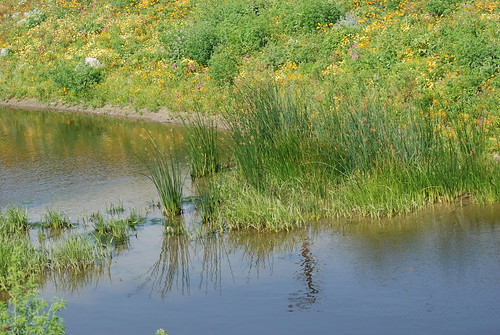
Tules and other wetland plants separate the cells.
The slopes of Dominguez Gap are flowering with a riot of colors right now.

The yellow spikes of flowers are false-lupines (Thermopsis macrophylla). In addition, poppies, sages, chia, and limnanthus were flowering profusely.

This hummingbird sage (Salvia spathacea) is more typical of oak-woodland habitat.
The landscapers were clearly going for more of a "grassland" than coastal sage-scrub, which may have been more appropriate. But I'm sure they had their reasons. No doubt the appearance of the wetlands will change drastically as the plants duke it out with each other (and the inevitable invasion of mustards and other weeds). Sapling cottonwoods and sycamores may eventually tower over the whole park.
The plants may have been utterly delicious to these caterpillars:
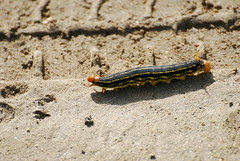
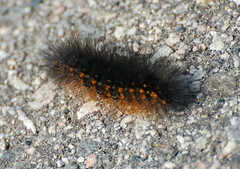
Not sure which species they were, but there were hundreds of them on the trails!
Perhaps some would turn into mourning cloaks, like this one I saw:
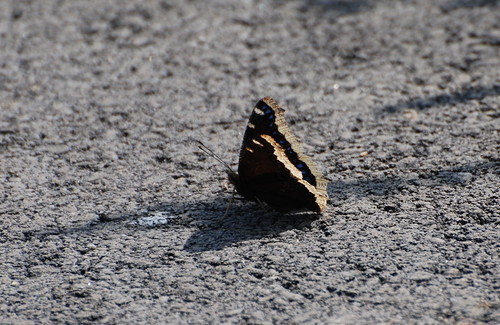
Needless to say, the birds weren't letting the abundance go to waste, as this mockingbird shows us:
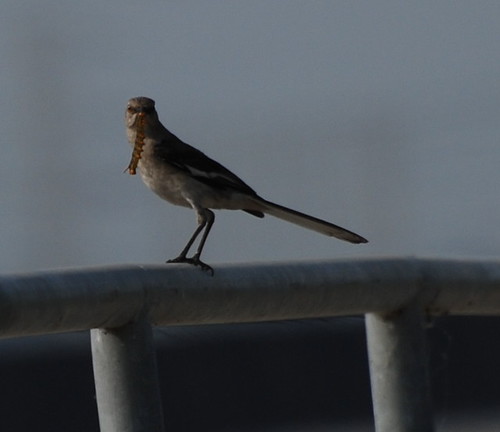
The birdlife was fantastic. I saw huge flocks of blackbirds, including red-winged, tricolored, and yellow-headed blackbirds.
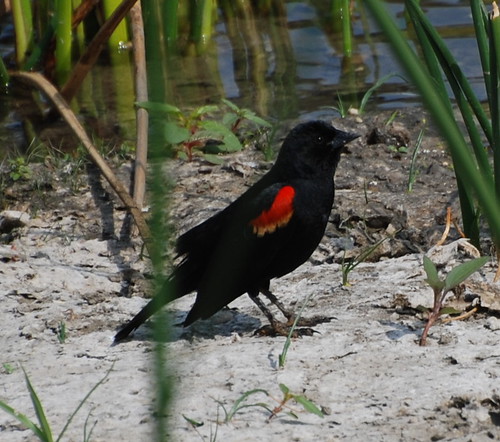
Red-winged blackbirds (Agelaius phoeniceus) are common birds in marshes, and will probably do well at Dominguez Gap. Their songs are beautiful and evocative.
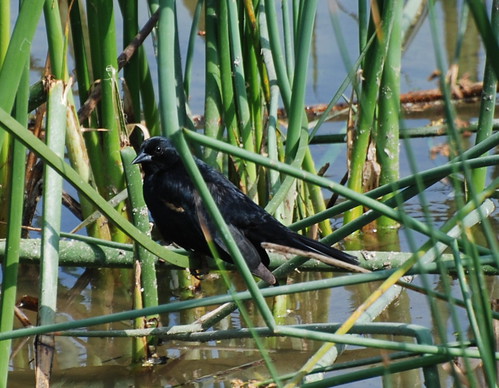
Tricolored blackbirds (Agelaius tricolor) are much rarer (in fact, they are species of special concern in California). They have similar wings (with white replacing the yellow on the epaulets), but the black is also much glossier.
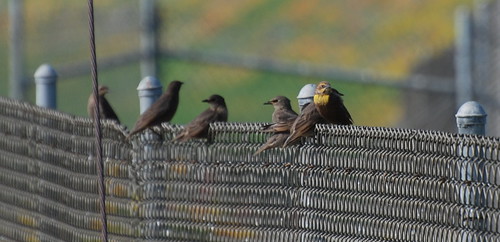
Yellow-headed blackbirds (Xanthocephalus xanthocephalus) were new to me! They traveled in the largest flocks (which included the other species of blackbirds, as well as a few starlings). Very cool-looking creatures!
Some other neat birds at this park:
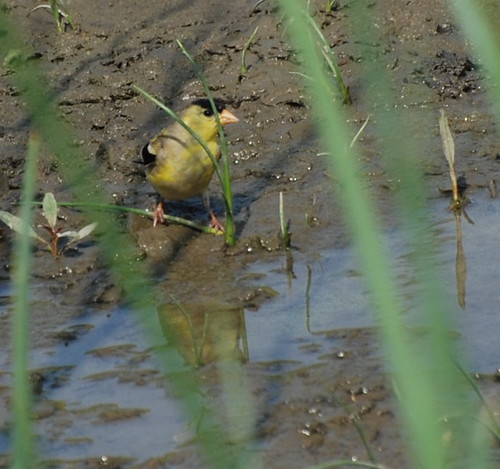
American goldfinch (Carduelis tristis)
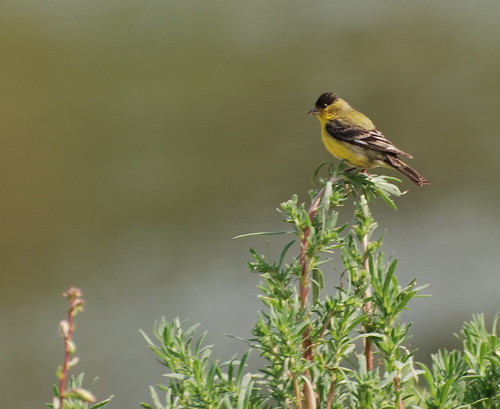
Lesser goldfinch (Carduelis psaltria). It's distinguished from the American goldfinch by its larger black cap.
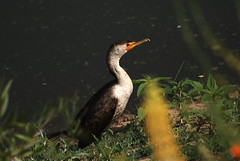
Double-crested cormorant (Phalacrocorax auritus)
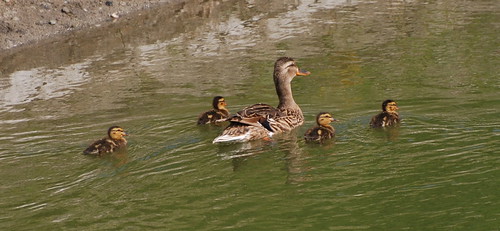
A mother mallard and ducklings!
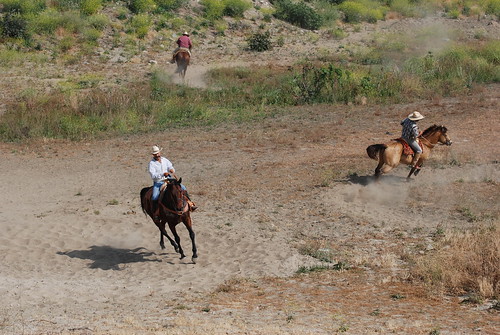
Oh, and cowboys!
Sorry about the cold shoulder... I've been--distracted. By things. Plus, there weren't too many wildernesses left to explore in Long Beach!
All that changed this past weekend, though. We have a brand new wetland!
The Dominguez Gap Wetlands were officially opened to the public this May.

These wetlands are located along the LA River south of Del Amo Boulevard, adjoining DeForest Park. But unlike DeForest, this isn't techinically a "park" and it isn't managed by the Long Beach Parks Department. Instead, it's managed by the LA County Department of Public Works.
Adjacent to the park, you can see the confluence of Compton Creek and the LA River:

These wetlands aren't at all natural--they were constructed and serve a variety of purposes. Specifically, the wetlands are designed to treat stormwater (removing nutrients and metals before it enters the LA River and the Pacific Ocean. It will also help recharge the groundwater in the area. In addition, the wetland provides habitat for wildlife. And wetland-dependent wildlife is desparate for real estate in southern LA County! (You can learn more about constructed treatment wetlands in this PDF from the EPA).

As you can see, the wetlands are built so that water enters individual cells. In each cell, nutrients and pollutants are removed, before passing on to the next cell. As the water moves through the wetland, more and more pollutants are removed.

Tules and other wetland plants separate the cells.
The slopes of Dominguez Gap are flowering with a riot of colors right now.

The yellow spikes of flowers are false-lupines (Thermopsis macrophylla). In addition, poppies, sages, chia, and limnanthus were flowering profusely.

This hummingbird sage (Salvia spathacea) is more typical of oak-woodland habitat.
The landscapers were clearly going for more of a "grassland" than coastal sage-scrub, which may have been more appropriate. But I'm sure they had their reasons. No doubt the appearance of the wetlands will change drastically as the plants duke it out with each other (and the inevitable invasion of mustards and other weeds). Sapling cottonwoods and sycamores may eventually tower over the whole park.
The plants may have been utterly delicious to these caterpillars:


Not sure which species they were, but there were hundreds of them on the trails!
Perhaps some would turn into mourning cloaks, like this one I saw:

Needless to say, the birds weren't letting the abundance go to waste, as this mockingbird shows us:

The birdlife was fantastic. I saw huge flocks of blackbirds, including red-winged, tricolored, and yellow-headed blackbirds.

Red-winged blackbirds (Agelaius phoeniceus) are common birds in marshes, and will probably do well at Dominguez Gap. Their songs are beautiful and evocative.

Tricolored blackbirds (Agelaius tricolor) are much rarer (in fact, they are species of special concern in California). They have similar wings (with white replacing the yellow on the epaulets), but the black is also much glossier.

Yellow-headed blackbirds (Xanthocephalus xanthocephalus) were new to me! They traveled in the largest flocks (which included the other species of blackbirds, as well as a few starlings). Very cool-looking creatures!
Some other neat birds at this park:

American goldfinch (Carduelis tristis)

Lesser goldfinch (Carduelis psaltria). It's distinguished from the American goldfinch by its larger black cap.

Double-crested cormorant (Phalacrocorax auritus)

A mother mallard and ducklings!

Oh, and cowboys!
Subscribe to:
Posts (Atom)
